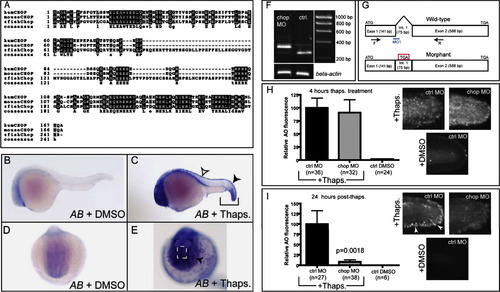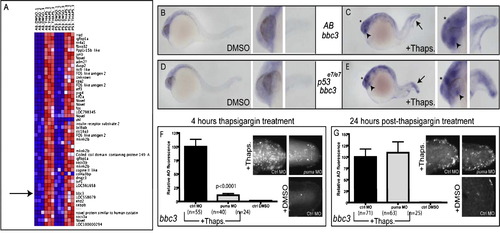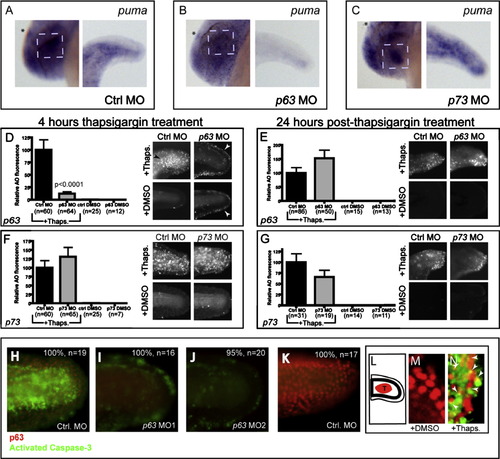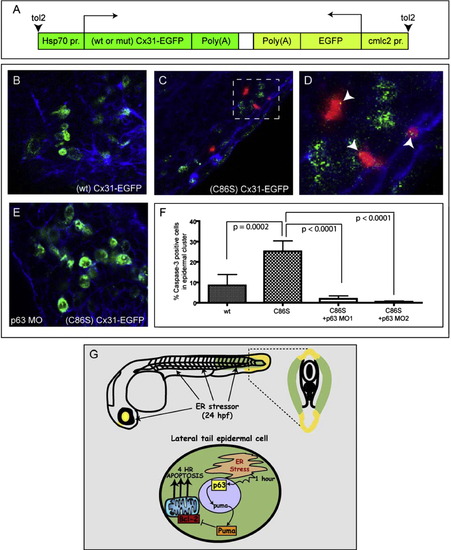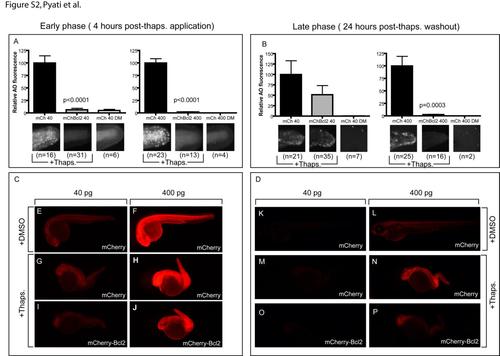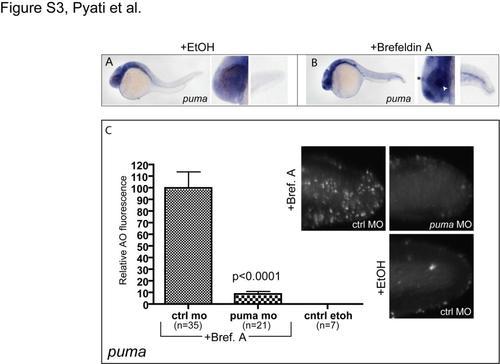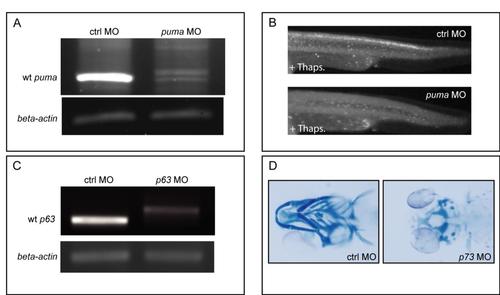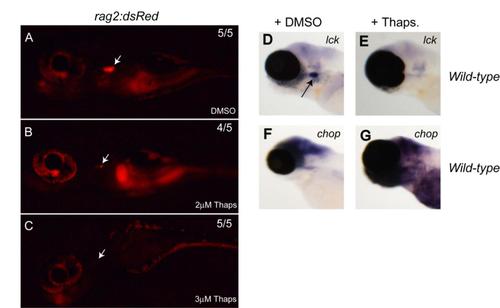- Title
-
p63 Mediates an Apoptotic Response to Pharmacological and Disease-Related ER Stress in the Developing Epidermis
- Authors
- Pyati, U.J., Gjini, E., Carbonneau, S., Lee, J.S., Guo, F., Jette, C.A., Kelsell, D.P., and Look, A.T.
- Source
- Full text @ Dev. Cell
|
ER Stressors Trigger bip Upregulation and Apoptosis in the Lens, Epiphysis, and Tail Epidermis of 24 Hpf Zebrafish Embryos Embryos (24 hpf) from an AB incross or a stage-matched p53 homozygous mutant incross were treated with a DMSO vehicle or 5 μM thapsigargin for 4 hr, fixed, and assayed for apoptosis by TUNEL labeling. (A–C) Scattered cells in AB DMSO-treated control embryos (n = 29) showed TUNEL positivity. (D–F) Thapsigargin-treated AB embryos had increased TUNEL positivity that was concentrated in the epiphysis, lens, and tail (93% of embryos with increased apoptosis, n = 30). (G–I) p53 homozygous mutant embryos treated with DMSO (n = 31) showed comparable levels of TUNEL positivity to AB DMSO-treated embryos. (J–E1) p53 homozygous mutant embryos treated with thapsigargin showed increased apoptosis in the same regions as in AB embryos (100% of embryos with increased apoptosis, n = 31). Like thapsigargin treatment, Brefeldin A treatment (5 ug/ml) caused increased apoptosis in the lens, epiphysis, and tail (P–R) compared to vehicle-treated controls (M–O) (see also Figure S1). Compared to DMSO-treated controls (S and U), bip expression was upregulated in embryos treated for 3 hr with thapsigargin (T and V). In cryosections, DMSO controls (W–Y) had minimal apoptosis, while thapsigargin treatment of both AB embryos (Z–B1) and p53 mutant embryos (C1–E1) caused extensive enriched apoptosis in the tail epidermis (white arrowheads). In (A)–(R), zoomed images of head and tail are shown at the right of corresponding whole-embryo images. Asterisks indicate epiphysis, arrowheads the lens, and arrows the tail in thapsigargin-treated embryos. |
|
Thapsigargin Treatment Rapidly Activates Conserved Vertebrate ER Stress Pathways to Induce Apoptosis (A–D) TUNEL staining was performed in fixed embryos after (A) 4 hr of DMSO treatment or after (B) 1 hr, (C) 2 hr, or (D) 4 hr of thapsigargin treatment. (C) Increased apoptosis was first apparent in the tail by 2 hr of thapsigargin treatment, but robust apoptosis in the lens, epiphysis, and tail was evident only after (D) 4 hr of thapsigargin treatment compared to DMSO controls at the same stage. All images are representative of embryos examined at each time point (n = 10 in all treatments except D, where n = 9). (E) By RT-PCR, xbp-1 splicing in the Ire-1 pathway was first apparent after 45 min of thapsigargin treatment, and was maintained over 4 hr. Note the lower band present from 45 min on, which corresponds to the nonconventional splice-form downstream of Ire-1 activation. (F) Antiphospho eIF2α immunoblots showed that eIF2α was robustly phosphorylated in the Perk pathway from 1 hr through the end of the thapsigargin time-course. Total eIF2α was immunoblotted as a loading control after stripping of the original blot. |
|
Zebrafish Chop Is Dispensable for Rapid ER Stress-Induced Apoptosis, but Is Required for 24 Hr Apoptosis in the Caudal Fin Fold (A) Alignment of zebrafish Chop with human and mouse orthologs. Consensus sequence is listed below the aligned sequences. (B–D) DMSO-treated embryos have minimal chop expression, while embryos treated with thapsigargin for 3 hr (C) have high levels of chop expression in the tail (brackets), including the tail epidermis (black arrowhead). Expression was also observed in the dorsal trunk epidermis (open arrowhead in C). (E) An anterior view reveals additional chop expression in the epiphysis region (dashed white box) and the lens (black arrowhead). Images in (B)–(E) represent 100% of embryos examined; n e 14 embryos per condition. (F) Agarose gel (1%) showing alternate splice product generated 28 hr after chop morpholino (MO) injection compared to uninjected controls (Ctrl.); both groups of embryos were treated with thapsigargin at 24 hpf. (G) Depiction of splice-blocking event in chop morphant mRNA compared to wild-type, as determined by sequencing. (H) chop morpholino (5 ng) was injected into p53 homozygous mutant embryos, which were then grown to 24 hpf, treated with thapsigargin for 4 hr, and assayed for cell death by AO staining. Cropped photos were quantitated for total fluorescence intensity with Volocity software, and values were normalized to controls. (I) chop morpholino-injected embryos were grown to 24 hpf, treated with thapsigargin for 4 hr, washed into egg medium, left for 24 hr, and then stained with AO and assayed as in (H). All data are represented as means ± SEM. EXPRESSION / LABELING:
|
|
puma Expression Is Increased in a p53-Independent Manner Following Thapsigargin Treatment (A) Microarray analysis of dissected tail tissue revealed increased puma expression following thapsigargin treatment in both AB and p53 mutant embryos. (B–E) Compared to DMSO-treated controls (B), thapsigargin-treated embryos (C) had increased puma expression in the tail (arrow), epiphysis (asterisk), and lens (arrowhead). This increased expression was also observed in thapsigargin-treated p53 mutant embryos (E) compared to DMSO-treated controls (D). (F and G) Knockdown of puma attenuated 4 hr ER stress-induced apoptosis, but not (G) 28 hr ER stress-induced apoptosis. See also Figure S2 and Figure S3. EXPRESSION / LABELING:
|
|
p63, but Not p73, Is Required for ER Stress-Induced puma Expression and 4 Hr Apoptosis (A and B) Compared to thapsigargin-treated control morphants (100% with high puma expression, n = 16) thapsigargin-treated p63 morphants had reduced puma expression in the epiphysis, lens, and tail (78% with reduced expression, n = 18). (C) Thapsigargin-treated p73 morphants had similar puma expression (94%, n = 18) compared to control morphants. Asterisk, epiphysis; dashed box, lens. (D and E) p63 and control morphants were assayed for apoptosis by AO staining at 4 hr after thapsigargin or DMSO treatment, or (E) washed out and assayed by AO staining 24 hr later. See also Figure S4 and Figure S5. In (D), note the weak AO staining in the outer fin epidermis (white arrowheads) of p63 morphants, regardless of thapsigargin treatment, but the nearly complete block of cell death in the lateral epidermis compared to the same region in thapsigargin-treated control morphants (black arrowhead). (F and G) p73 morphants were processed the same as for p63 morphants. p73 morpholino injection does not block either (F) 4 hr thapsigargin-induced apoptosis or (G) 28 hr thapsigargin-induced apoptosis. (H–J) Embryos were injected with either (H) control morpholino, (I) p63 MO1 or (J) p63 MO2, then treated with thapsigargin for 4 hr and assayed for p63 expression (red) and activated Caspase-3 (green) by immunofluorescence microscopy. Note the severe reduction in p63 and Caspase-3 expression in both p63 morphants (I and J) compared to control morphants (H). (K) Control embryos treated with DMSO showed extensive p63 expression with minimal Caspase-3 positivity. (L–N) Confocal analysis of coimmunofluorescence in embryos treated with DMSO (M) or thapsigargin (N) to analyze p63 expression (red) and activated Caspase-3 (green). Note the extensive colocalization of activated Caspase-3 with p63 in (N), marked with arrowheads. (L) A schematic representation of the imaged region in (M) and (N). All graphical data are represented as means ± SEM. EXPRESSION / LABELING:
|
|
p63 Is Required for Apoptosis Induced by a Mutant Connexin 31 Construct Associated with Human EKV Disease (A) Overview of the Cx31 DNA constructs used in this study. (B–F) p53 mutant embryos were injected with wt or (C86S) mutant Cx31-EGFP constructs, then heat shocked at 24 hpf to induce Cx31-EGFP expression, fixed at 2 hr later, and processed for anti-EGFP (green), anti-activated Caspase-3 (red) and phalloidin staining (blue). See also Figure S6. (B) (wt) Cx31-EGFP caused minimal apoptosis. (C) (C86S) Cx31-EGFP caused a higher level of epidermal apoptosis than (wt) Cx31-EGFP. (D) Zoomed region from (C). (E) Coinjection of p63 MO1 blocked the apoptosis induced by (C86S) Cx31-EGFP. (F) Quantification of apoptosis expressed as % Caspase-3 positive cells in an EGFP positive epidermal cluster. At least eight embryos per condition were used for quantitation. (G) A model for the mechanism of ER stress-induced apoptosis in the developing epidermis. |
|
related to Figure 1: Brefeldin A treatment causes increased bip and chop expression in zebrafish embryos As with thapsigargin treatment, Brefeldin A treatment (5μg/ml) causes increased expression of bip (A) as compared to ethanol treated embryos (B). chop expression is also increased after Brefeldin A treatment (C) as compared to ethanol treated control embryos (D). |
|
related to Figure 4: Bcl-2 overexpression in zebrafish embryos blocks the early and late apoptotic response after thapsigargin treatment. Embryos injected with mRNAs encoding mCherry or mCherry-Bcl-2 were treated with thapsigargin to induce an early (A, C) or late (B, D) apoptotic response which was analyzed by AO staining. (A) Cropped photos were quantitated for total fluorescence intensity with Volocity software, and values were normalized to controls. Thapsigargin treatment induces early phase apoptosis (A) and late phase apoptosis (B) in embryos injected with 40 or 400 pg mCherry mRNA (mCh 40 or mCh 400 respectively) but not in embryos injected with 40 or 400 pg mCherry-Bcl-2 mRNA (mChBcl2 40 or mChBcl2 400 respectively). No early-phase apoptosis (A) and late-phase apoptosis (B) was observed in embryos injected with 40 or 400 pg mCherry mRNA and treated with DMSO. (C) After 4 hours post thapsigargin treatment, Cherry fluorescence expression, visualized by microscopy, is similar in embryos treated with DMSO (E, F) or thapsigargin (G, H, I, J) and injected either with mCherry alone (E, F, G, H) or with mCherry-Bcl-2 (I, J), for both 40pg and 400 pg concentrations respectively. (D) After 24 hours post thapsigargin treatment, mCherry fluorescence expression, visualized by microscopy, is very weak in embryos injected with 40pg of either mCherry (K, M) or mCherry-Bcl-2 mRNA (O) for both DMSO (K) and thapsigargin treated (M, O) groups. mCherry fluorescence expression is detectable and similar in embryos injected with 400pg (L, N, P) of either mCherry (L, N) or mCherry-Bcl-2 mRNA (P) for both DMSO (L) and thapsigargin treated groups (N, P). |
|
related to Figure 4: Brefeldin A treatment increases puma expression and ER-stress induced apoptosis in zebrafish embryos. Brefeldin A (5μg/ml) treatment causes increased puma expression in the lens and tail (B) regions compared to ethanol treated zebrafish embryos (A). In Brefeldin A treated embryos, puma knockdown strongly blocks the 4-hour apoptotic response in the lateral tail epidermis (puma mo) as compared to embryos treated with ethanol (cntrl etoh) or embryos injected with a control morpholino (ctrl mo) (C). The apoptotic response was analyzed by AO staining. Cropped photos of zebrafish tail regions were quantitated for total fluorescence intensity with Volocity software, and values were normalized to controls. (Black asterisk shows the epiphysis; white arrowhead shows the lens) |
|
related to Figure 5: Knockdown of puma rescues the ER-stress induced apoptosis in skin epidermis of zebrafish embryos treated with thapsigargin. Morpholinos against puma (A) and p63 (C) yield effective knockdown based on RT-PCR levels. (A) A decrease in the puma transcript is observed compared to the puma transcript in control morpholino injected embryos. (B) Knockdown of puma rescues the ER-stress induced apoptosis in skin epidermis of zebrafish embryos treated with thapsigargin. (C) RT-PCR levels for p63 where also decreased in embryos injected with the p63 morpholino compared to control morpholino injected embryos. (D) Knockdown of p73 causes jaw cartilage defects in zebrafish embryos, as previously reported, verifying the effectiveness of the p73 knockdown in embryos injected with the p73 morpholino and analyzed for rapid ER-stress induced apoptosis post-thapsigargin treatment (Alcian blue staining). |
|
related to Figure 5: Knockdown of p63 rescues the ER-stress induced apoptosis in skin epidermis of zebrafish embryos treated with brefeldin A or thapsigargin Embryos injected with the p63 morpholino were treated either with Brefeldin A (A) or with thapsigargin (B) and the apoptosis observed in the tail epidermis was analyzed by AO staining. Cropped photos of zebrafish tail regions were quantitated for total fluorescence intensity with Volocity software, and values were normalized to controls. As shown in the graph, p63 knockdown (p63 mo) in embryos treated with Brefeldin A, rescues the ER-stress induced cell death as compared to control embryos treated with ethanol (ctrl etoh) or embryos injected with control morpholinos (ctrl mo) (A). p63 knockdown (p63 mo) in embryos treated thapsigargin rescues the ER-stress induced cell death as compared to control embryos treated with DMSO (ctrl dmso) or embryos injected with control morpholinos (ctrl mo) (B). |
|
related to Figure 7: Expression of Connexin-31 with a C86S mutation, but not wild-type Connexin-31, causes apoptosis in the tail epidermis of zebrafish embryos. Heat-shock for 30 minutes triggers nearly ubiquitous expression of the (wt)Cx31-EGFP (A,B) and (C86S)Cx31-EGFP but not of cmlc2 (C, D). After 30 min of heat-shock, a severe phenotype is observed in (C86S)Cx31-EGFP injected embryos (G,H) with disruption of skin epidermis as compared to (wt)Cx31-EGFP injected embryos (E,F). (white arrowhead shows expression of cmlc2-EGFP in the heart) |
|
related to Figure 4: Thapsigargin treatment leads to a loss of thymocytes in 5 day old zebrafish embryos. Using the thymocyte specific reporter line, Tg(rag2:dsRed), we observed that thapsigargin treatment leads to a loss of thymocytes in 5 day old embryos as depicted in B (2μM thapsigargin treatment) and C (3μM thapsigargin treatment) as compared with DMSO treated control embryos (A). This phenotype is accompanied by decrease in lck expression in thapsigargin treated embryos (E) compared to DMSO treated control embryos (D) and an increase in chop levels in embryos treated with thapsigargin (G) compared to DMSO treated embryos (F). (white arrows in A,B and C, and black arrow in D show thymus) |
Reprinted from Developmental Cell, 21(3), Pyati, U.J., Gjini, E., Carbonneau, S., Lee, J.S., Guo, F., Jette, C.A., Kelsell, D.P., and Look, A.T., p63 Mediates an Apoptotic Response to Pharmacological and Disease-Related ER Stress in the Developing Epidermis, 492-505, Copyright (2011) with permission from Elsevier. Full text @ Dev. Cell



